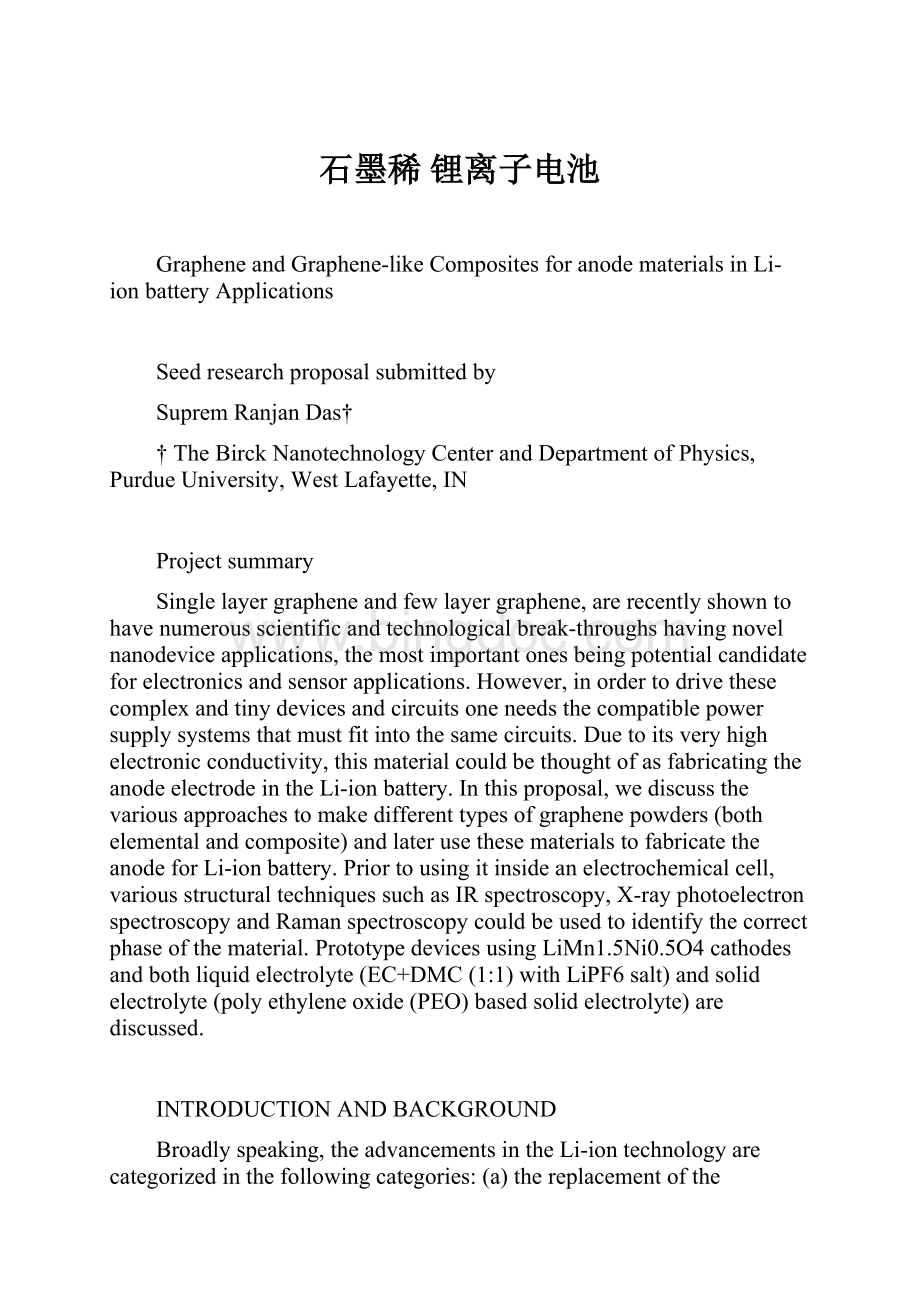石墨稀 锂离子电池.docx
《石墨稀 锂离子电池.docx》由会员分享,可在线阅读,更多相关《石墨稀 锂离子电池.docx(11页珍藏版)》请在冰点文库上搜索。

石墨稀锂离子电池
GrapheneandGraphene-likeCompositesforanodematerialsinLi-ionbatteryApplications
Seedresearchproposalsubmittedby
SupremRanjanDas†
†TheBirckNanotechnologyCenterandDepartmentofPhysics,PurdueUniversity,WestLafayette,IN
Projectsummary
Singlelayergrapheneandfewlayergraphene,arerecentlyshowntohavenumerousscientificandtechnologicalbreak-throughshavingnovelnanodeviceapplications,themostimportantonesbeingpotentialcandidateforelectronicsandsensorapplications.However,inordertodrivethesecomplexandtinydevicesandcircuitsoneneedsthecompatiblepowersupplysystemsthatmustfitintothesamecircuits.Duetoitsveryhighelectronicconductivity,thismaterialcouldbethoughtofasfabricatingtheanodeelectrodeintheLi-ionbattery.Inthisproposal,wediscussthevariousapproachestomakedifferenttypesofgraphenepowders(bothelementalandcomposite)andlaterusethesematerialstofabricatetheanodeforLi-ionbattery.Priortousingitinsideanelectrochemicalcell,variousstructuraltechniquessuchasIRspectroscopy,X-rayphotoelectronspectroscopyandRamanspectroscopycouldbeusedtoidentifythecorrectphaseofthematerial.PrototypedevicesusingLiMn1.5Ni0.5O4cathodesandbothliquidelectrolyte(EC+DMC(1:
1)withLiPF6salt)andsolidelectrolyte(polyethyleneoxide(PEO)basedsolidelectrolyte)arediscussed.
INTRODUCTIONANDBACKGROUND
Broadlyspeaking,theadvancementsintheLi-iontechnologyarecategorizedinthefollowingcategories:
(a)thereplacementofthecarbonaceousmaterialswithalternativelow-voltage,Li-acceptinganodecompounds,withtheaimofimprovingsafetycharacteristics,(b)thereplacementofcobaltwithnickelormanganeseinthecathodestructure,withtheaimofreducingcostandtheenvironmentaltoxicity,and(c)thereplacementoftheliquid-likeelectrolytewitha(solid)polymerelectrolyte(aplasticlikemembranewhichcanactbothasanelectrolyteandaseparator)withtheaimofimprovingbatterydesign,reliability,andflexibilies.
Thisresearchproposalisintendedtostudythepossibilitiesofusingthegrapheneandgraphene-likecompositesforuseasananodematerialinsecondary(Li-ion)battery.
SincetheinventionoffirstgenerationofLi-ionbatteriesusingso-calledRocking-chairtechnologiesbySonyEnergytecInc.andMoliEnergyLtd.duringlate90’s,numerouscarbonaceousanodematerialsarebeingemployedinLi-ionbatteries[1-3].Evenbeforethat,duetothelimitedrechargeabilityandsafetyhazardconcernsofLi-anodebatteriesattractedtheattentionofcarbonaceousanodes.HOPGwasusedasthepositiveelectrode(cathode)incellshavingpureLianodes[4]andlaterpyrolyticcarbonanodeandmetaloxidecathode(vanadiumoxideandchromiumoxide)wereusedinearlyrechargeablebatteries[5].Thelowcostandlowoperationalvoltagesofcarbonaceousmaterialsinitiallymotivatedgraphiteandcokefortheuseofanodes(calledsoftanodes)intheLi-ionbatteriescoupledwithhighvoltagecathode(likeLiCoO2),sothatabatteryoperatingin4Vrangelargelycommercialized[6].Thecontinuedefforts,bothbytheresearchersandindustries,sincethenhaveconsistentlyenhancedthecarbonaceousanodeperformance,alongwithitsreliabilitiesandsafety(apartfromissuesonpositiveelectrodeandtheelectrolyte).However,becauseoflotsofcomplexitiesintheoperationsandstabilitiesofthedeviceinthemicroscopicscale,andvariousemergingnewmaterialsmanyunsolvedissuesaswellasimproveddevicesremainshopefulforresearchinthisarea.Althoughrecentyearsmanyalternativetocarbonaceousanodes(e.g.,Lithiumandmetalalloys)withmuchhighercapacityhavebeenreported,buttheyareprolongedtothesocalledpulverizationeffectswhichlimitsitspracticalusegreatly.So,carbonaceousmaterialsremainintheheartofthefabricationofanodesinLi-ionbatteries.
ThemechanismofLi-intercalationinsoftcarbonanodesisthat,itdevelopsthroughwellidentified,reversiblestagescorrespondingtoprogressiveintercalationwithindiscretegraphenelayers,reachingintotheformationofLiC6.Thetheoreticalvalueofthedischargecapacityoflithiatedcarboniscalculatedtobe372mAh/gmbasedonthecharge/dischargereaction6C+Li↔LiC6[7],extendingtheprocesstotherangeoffewmVvs.Li.However,sincethisiswellbelowthedecompositionlimitofseveralcommonelectrolytes(electrolytedecompositionresultsalwaysasurfaceprotectivefilmthatallowsthecontinuousoperationoftheanode),theseanodessufferfrompoorspecificcapacityandkinetics,althoughproducesmoresafetyandreversibilities[8].Thisisthemainmotivationforthesearchofothercarbonaceousanodes,withpossiblegreaterspecificcapacity,fasterkinetics,higherreliabilityandretainingthesafetyissues.Severalformsofcarbonwithcapacitieshigherthangraphiteandcokearebeingreportedintheliteraturesincethebeginningofthelastdecade,includinghardcarbons(disorderedcarbons).Thechargestoragemechanismsinthesecarbonsareneitherwellunderstoodnorisuniqueinalltheformsofcarbonanode[9].Variouskindsofcarbonwithwiderangeofcrystallinity(e.g.1.carbonfibers)aswellas
(2)highlydisorderedformsofcarbon(poly-p-phenylene(PPP)-basedcarbon)werestudiedasanodematerials.Otherformsofcarbonstudiedare(3)specialtypesoflowtemperatureformsofcarbon,suchasthatderivedfromphenolicresin,(4)mesocarbonmicrobeads(MCMB)–lowtemperatureheat-treatedMCMBsarereportedwithhighcapacities[10],(5)poly-p-phenylene(PPP)–PPPheattreatedat7000CinH2atmospherehascapacity~680mAh/gm[11].Carbonandgraphiticmaterialshavelargevarietyinmicrostructures,texture,morphology,andcrystallinity,dependingontheirpreparationprocessesandprecursormaterials,aswellasofvariousformssuchaspowders,fibers,spherulesetc.Also,recentlyalargenumberofvariousformsofcompositematerialsofcarbonanddifferentothermaterialsarebeingreportedinliterature(Appendix).However,thebasisonwhichthesematerialschosenareneitherquitewellexplainedintheliteraturenoritisknownwell.However,theideasofusingabovementionedfewformsofcarbonaresummarizedasfollows:
Mostofthecharginganddischargecapacityatanode(chargingmeansLiinsertionintoanodeanddischargingmeansLiremovalformcarbon(oppositeterminologyascomparedtotheterminologyforacathodeorthebattery))areexplainedonthebasisofcavitymodel(Liionnotonlyintercalatedinto/outofthecarbonlayersbutalsodopedinthenanocavities.Forexample,highcapacityMCMBshascavitieswiththesizeof0.5-1.5nm).
OBJECTIVE
ThisprojectreportfocusestheuseofsinglelayergrapheneandmultilayergraphenesheetsofvarioussizestofabricatetheLi-ionbatteryanode,anduseofthesameinaprototypeLi-ioncellcomprisingofLiMn1.5Ni0.5O4cathodeandbothEC+DMC(1:
1volume)withLiPF6liquidelectrolyteandPEObasedsolidelectrolyte.
Theideaofsuperiorbehaviorofgraphenesheetsforanodematerials(dischargecapacity~560mAh/gm)isratherlooselyreportedbyDahnet.al.[12],thoughtheyhavenotfocusedtheirattentiontheimportanceofhavingpuregraphemeelectrodeandtheirbehaviorforLi-intercalation/deintercalation.Withthepresentandfutureresearchinmajorityofthescientificandengineeringfieldsdriventowardsnanodirection,Li-ionbatteryresearchnomoreremainsanexception.Allthethreevitalcomponentsofanelectrochemicalcell(namelyanode,cathodeandelectrolyte)arepotentiallybecominginterestingmaterialstostudywiththeadventofnanotechnologyandlotsofsuccessachievedoverwidevarietyofexperimentalandtheoreticaltechniques.Thoughtherearesomedisadvantageswhichneedstobestudieddependingontheparticularcases,recentlyitisarguedthatnanomaterials,becauseoftheirreduceddimensions,canprovidefarmorethananorderofmagnitudeimprovementofintercalation/deintercalationrates(andhencehighcharge/dischargeandsohighpower)inLi-ionbatteries[IntrinsicdiffusivityofLiioninthesolidstate(lithiumintercalationhost)is~10-8cm2s-1][13].However,useofnanoparticulategraphiteonotherhand,canformamuchmorereactivesolid-electrolyte-interface(SEI)layer(Li-iondeposition)ongraphitesurface,ratherthanaprotectiveSEIlayer,thiscreatesmajorsafetyproblem.ThoughCNTshavereportedlyproducedtwiceasmuchListoragecapacityasgraphite,butsimilarsafetyissuesaredebated.
Therearefewreportswhichsummarizefewpossiblewaysthatmightbeeffectiveforusingthecarbonastheanodematerialofchoicebutstillwithouttheabovestatedsafetyproblem.Wuetalreviewedtheeffectofmildoxidationofgraphite,formationofcompositeswithmetalsandmetaloxides[14].MicroencapsulatedgraphitewithnanosizedSilverandNickelmetalparticlestoformcompositeanodeswerereportedanditsstudyofsuppressionofcointercalationofsolvatedLiionsintographitecouldbeapotentialareaofstudythefutureanodematerialsforLi-ionbatteries.Moreoverinthisproject,wewanttoinvestigatethreeaspects:
(i)makingpureandbulkquantitiesofgraphenepowdersandgrapheneoxidepowders,(ii)makingcompositesofgraphenepowderswithmetalnanoparticles,and(iii)usinggrapheneoxidesandgraphene-metalparticlecompositestobuildnegativeelectrodes(anodes)forLi-ionbatteries.
Weexpectsuperiorbehavioroftheseintermsofcharge-dischargeperformance,Coulombicefficiency,andcycleabilityinaprototypecellusingLiPF6+EC+DMCliquidelectrolyteandLiMn1.5Ni0.5O4cathode,andlaterfurtherwanttoextendt